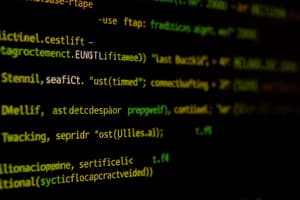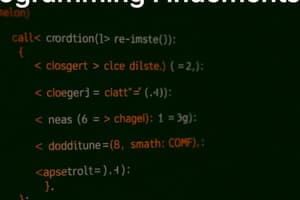Podcast
Questions and Answers
Which of the following scenarios is best addressed using a switch statement in C?
Which of the following scenarios is best addressed using a switch statement in C?
- Performing different actions based on the result of a complex boolean expression.
- Checking if a number is within a specific range.
- Repeating a block of code until a certain condition is met.
- Selecting an action based on the value of an integer variable. (correct)
What is the primary difference between a while loop and a do-while loop in C?
What is the primary difference between a while loop and a do-while loop in C?
- There is no difference; they are interchangeable.
- A `do-while` loop always executes at least once, whereas a `while` loop may not execute at all. (correct)
- A `while` loop always executes at least once, whereas a `do-while` loop may not execute at all.
- A `while` loop checks the condition at the end of the loop, whereas a `do-while` loop checks the condition at the beginning.
In C, what is the purpose of the break statement within a loop?
In C, what is the purpose of the break statement within a loop?
- To terminate the entire program.
- To skip the current iteration and move to the next iteration.
- To pause the loop for a specified amount of time.
- To exit the loop prematurely, regardless of the loop condition. (correct)
Given an array int arr[5], which of the following is a valid way to access the third element of the array?
Given an array int arr[5], which of the following is a valid way to access the third element of the array?
What is the potential danger of using pointers without proper initialization in C?
What is the potential danger of using pointers without proper initialization in C?
Which of the following is a correct way to declare a pointer to an integer in C?
Which of the following is a correct way to declare a pointer to an integer in C?
When an array is passed to a function in C, what is actually passed?
When an array is passed to a function in C, what is actually passed?
What is the purpose of the malloc() function in C?
What is the purpose of the malloc() function in C?
Which of the following string functions is used to compare two strings in C?
Which of the following string functions is used to compare two strings in C?
How can dynamic arrays be created in C?
How can dynamic arrays be created in C?
What will be the output of the following code snippet?
int x = 10;
int *p = &x;
*p = 20;
printf("%d", x);
What will be the output of the following code snippet?
int x = 10;
int *p = &x;
*p = 20;
printf("%d", x);
What is the purpose of the continue statement in a loop?
What is the purpose of the continue statement in a loop?
What is the significance of the null character '\0' in C strings?
What is the significance of the null character '\0' in C strings?
Consider the code: int arr[3][2] = {{1,2}, {3,4}, {5,6}};. How would you access the element with value 4?
Consider the code: int arr[3][2] = {{1,2}, {3,4}, {5,6}};. How would you access the element with value 4?
What is pointer arithmetic?
What is pointer arithmetic?
Given the following code, what will be the output?
int arr[] = {10, 20, 30};
int *ptr = arr;
printf("%d ", *ptr++);
printf("%d", *ptr);
Given the following code, what will be the output?
int arr[] = {10, 20, 30};
int *ptr = arr;
printf("%d ", *ptr++);
printf("%d", *ptr);
Which of the following is NOT a valid use of pointers?
Which of the following is NOT a valid use of pointers?
What is the potential issue with the following code snippet?
int *ptr;
*ptr = 10;
What is the potential issue with the following code snippet?
int *ptr;
*ptr = 10;
How does C handle multi-dimensional arrays in memory?
How does C handle multi-dimensional arrays in memory?
When should you use calloc() instead of malloc()?
When should you use calloc() instead of malloc()?
Flashcards
Algorithms
Algorithms
Step-by-step procedures for solving a problem.
Data Structures
Data Structures
Ways of organizing and storing data for efficient access and modification.
Conditional Statements
Conditional Statements
Executes code blocks based on a condition's truthiness.
if Statement
if Statement
Signup and view all the flashcards
else Statement
else Statement
Signup and view all the flashcards
else if Statement
else if Statement
Signup and view all the flashcards
Switch Case
Switch Case
Signup and view all the flashcards
Loops
Loops
Signup and view all the flashcards
for Loop
for Loop
Signup and view all the flashcards
while Loop
while Loop
Signup and view all the flashcards
do-while Loop
do-while Loop
Signup and view all the flashcards
break Statement (in Loops)
break Statement (in Loops)
Signup and view all the flashcards
continue Statement
continue Statement
Signup and view all the flashcards
Pointer
Pointer
Signup and view all the flashcards
& Operator
& Operator
Signup and view all the flashcards
* Operator (with pointers)
* Operator (with pointers)
Signup and view all the flashcards
malloc()
malloc()
Signup and view all the flashcards
free()
free()
Signup and view all the flashcards
Array
Array
Signup and view all the flashcards
Character Arrays (Strings)
Character Arrays (Strings)
Signup and view all the flashcards
Study Notes
- Problem-solving in C involves breaking down complex problems into smaller, manageable parts that can be solved algorithmically and then translated into C code.
- Algorithms are step-by-step procedures for solving a problem, crucial for efficient programming.
- Data structures are ways of organizing and storing data to allow efficient access and modification.
Conditional Statements
- Conditional statements (e.g.,
if,else if,else) execute different code blocks based on whether a condition is true or false. - The
ifstatement executes a block of code if a specified condition is true. - The
elsestatement provides a block of code to execute if theifcondition is false. - The
else ifstatement allows for multiple conditions to be tested in sequence. - Nested
ifstatements can be employed for more complex decision-making scenarios. - Switch case statements provide a multi-way branch based on the value of a variable.
- Switch statements are useful when a variable needs to be compared against multiple constant values.
- The
breakstatement is used to exit from a switch case after a match is found. - A
defaultcase can be included to handle situations where no match is found.
Loops
- Loops are used to repeat a block of code multiple times.
- C provides
for,while, anddo-whileloops. - A
forloop is typically used when the number of iterations is known in advance. - The
forloop consists of initialization, condition, and increment/decrement expressions. - A
whileloop repeats a block of code as long as a specified condition is true. - The condition is checked at the beginning of each iteration.
- A
do-whileloop is similar to awhileloop, but the condition is checked at the end of each iteration. - This ensures that the loop body is executed at least once.
- The
breakstatement can be used to exit a loop prematurely. - The
continuestatement skips the rest of the current iteration and proceeds to the next iteration. - Nested loops involve placing one loop inside another, useful for processing multi-dimensional data structures.
Pointers
- A pointer is a variable that stores the memory address of another variable.
- Pointers are declared using the asterisk
*symbol. - The
&operator is used to get the address of a variable. - The
*operator is used to dereference a pointer, accessing the value stored at the memory address it holds. - Pointer arithmetic allows incrementing or decrementing pointers to navigate through memory locations.
- Pointers can be used to pass arguments by reference to functions, allowing functions to modify the original variables.
- Dynamic memory allocation is managed using pointers.
malloc()allocates a block of memory, andfree()releases the allocated memory.- Using pointers without proper initialization can lead to segmentation faults or undefined behavior.
- Null pointers are pointers that do not point to any valid memory location, often used to indicate that a pointer is not currently in use.
Arrays
- An array is a collection of elements of the same data type, stored in contiguous memory locations.
- Array elements are accessed using an index, starting from 0.
- Arrays can be single-dimensional or multi-dimensional.
- Multi-dimensional arrays are arrays of arrays.
- Arrays can be passed to functions as arguments.
- When an array is passed to a function, it decays into a pointer to the first element of the array.
- Character arrays (strings) are terminated by a null character
\0. - Strings are often manipulated using functions from the
string.hlibrary. - Common string functions include
strcpy()for copying strings,strlen()for finding the length of a string, andstrcmp()for comparing strings. - Arrays and loops are often used together to process elements in the array.
- Bounds checking is important when working with arrays to prevent accessing memory outside the array's boundaries.
- Arrays can be initialized when they are declared, otherwise, they contain garbage values.
Pointers and Arrays
- Array names can be used as pointers; the name of an array is a pointer to its first element.
- Pointer arithmetic can be used to access array elements.
*(arr + i)is equivalent toarr[i].- Dynamic arrays can be created using pointers and dynamic memory allocation functions like
malloc()andcalloc(). - Pointers to arrays can be passed to functions, allowing for efficient manipulation of array elements.
- Arrays of pointers are useful for storing collections of strings or other data structures.
- Understanding the relationship between pointers and arrays is crucial for efficient memory management and manipulation in C.
- When using pointers to arrays, it's important to ensure that the pointer remains within the bounds of the array to avoid undefined behavior.
Studying That Suits You
Use AI to generate personalized quizzes and flashcards to suit your learning preferences.




